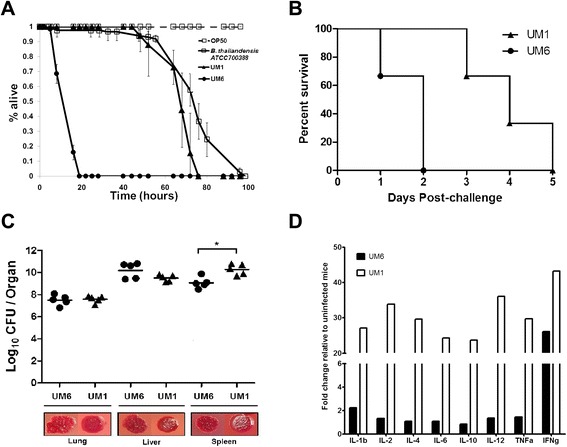Fig. 5.

B. pseudomallei biofilm may contribute to bacterial pathogenesis. a B. pseudomallei biofilm contributes towards lethality in C. elegans. One-day old Glp worms were transferred to individual B. pseudomallei isolates UM1 (black line, solid triangles), UM6 (black line, solid circles), B. thailandensis ATCC 700388 (black line, open squares) and E. coli OP50 (black dashed line, open squares). The graph shows the mean ± SD of three replicates (30 worms/replicate) from a representative of two independent experiments. b Mice (n = 5) were challenged intraperitonealy with a lethal dose of B. pseudomallei UM6 (circle) or UM1 (triangle) and their survival was monitored. Mice challenged with UM6 succumbed to disease significantly faster (within 24 h) than those challenged with UM1 [Logrank (Mantel-Cox) test, p-value = 0.0084]. c The bacterial loads in the spleen, liver and lung of B. pseudomallei-infected mice are shown. Each symbol represents one mouse. The horizontal line indicates the geometry mean for each group. Significance was determined using the Mann–Whitney test (*p < 0.05). Representative colony morphologies of B. pseudomallei UM1 and UM6 harvested from the infected mice organs are shown. d B. pseudomallei UM6 attenuates production of various cytokines. Lungs of BALB/c mice challenged with B. pseudomallei UM1 or UM6 were harvested and the levels of 12 pro- and anti-inflammatory cytokines were measured by the mouse cytokine Multi-Analyte ELISArray Kit (Qiagen). Cytokine expression is shown as fold increase compared to the control unchallenged mice
